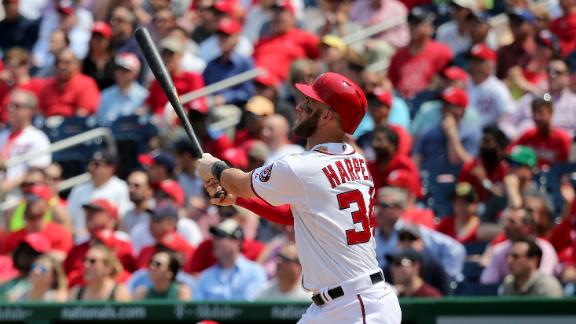

It’s an unprecedented collapse, with Fernando Tatis finding himself potentially third in the race behind Bryce Harper and Juan Soto. was the clear favorite for almost four months, before being passed by Bryce Harper on September 20th, a mere two weeks before the end of the season. Now comes the fun part! The graphic below from Sports Betting Dime shows the progression of odds to win NL MVP throughout the season.
/cdn.vox-cdn.com/uploads/chorus_image/image/60254325/usa_today_10921468.0.jpg)
Bryce Harper, Juan Soto or Fernando Tatis Jr.
#JUAN SOTO VS BRYCE HARPER STATS FULL#
There are some noticeable differences between TRC and TRC+, which can be attributed to players like Marcus Semien and Freddie Freeman accumulating more plate appearances than other players on the list, and thus having higher Total Run Creation over the full season, but less run creation on a per plate appearance basis. Finally, I combine wRC+ and DRS to get TRC+, which will also be centered around zero. For example, Eric Hosmer, Joey Wendle and Ian Happ are league average in value according to TRC. Taking it one step further, league average wRC over 600 plate appearances is 65 wRC, so to gauge which players are above and below league average (zero being average), I subtract 65 from each players’ wRC and then combine it with DRS to get full value above league average. Since wRC and DRS are on the same scale, I can combine them to get Total Runs Created (TRC). Now that we’ve identified two statistics that encapsulate value from an offensive and defensive perspective in the form of run creation, we can combine them into one statistic that will show total run creation. PlayerĭRS is a great statistic for grading defensive value because the players that visually amaze like Harrison Bader are almost always towards the top of the leaderboard and the players that are visually horrible like Rafael Devers are towards the bottom. Listed below are the top five and bottom five in DRS this season. While defensive metrics are not perfect, DRS is very accurate at crediting good defense and discrediting bad defense. To do this, we will use Defensive Runs Saved (DRS) which shows how many runs better or worse a player has been compared to the average player at his same position. Now that we have a stat that determines offensive value, we must factor defensive value into the equation. Overall, both wRC and wRC+ give optimal insight into complete offensive value. When analyzing an MVP race, games played gives important context into the full value a player actually provided to their team. wRC+ is calculated on a per plate appearance basis, so a smaller sample size does not hurt a hitter like Fernando Tatis, who missed time this season. The more common version of wRC is wRC+, which is weighted around 100 being average and every point above or below 100 is percentage better or worse than league average. Weighted Runs Created is a counting stat like runs batted in or home runs, so playing more games allows for more opportunities to create runs. Listed below are the top five in weighted runs created this season. It’s the perfect statistic for accurately assessing a player’s value at the plate over an entire season. As the season goes on, players create runs by compiling hits, walking and stealing bases. Weighted Runs Created is a metric that captures individual offensive value by assigning a run value to every outcome at the plate. Before we look at the results of Total Runs Created (TRC), let’s first go over how it’s created. Much like WAR, it aims to give a complete picture of a player’s offensive and defensive value. This stat is derived from Weighted Runs Created (wRC) and Defensive Runs Saved (DRS). In this article, I will be using a new stat called Total Runs Created and Total Runs Created+ to assist in my analysis. The aim of this article will be to analyze the MVP race from an unbiased point of view, as oddsmakers and talking heads have the power to sway our opinions on a whim. With the season coming to a close, one member of the Baseball Writers Association of America(BBWAA) from each MLB city will place their vote for who they deem the Most Valuable Player from each league.


 0 kommentar(er)
0 kommentar(er)
